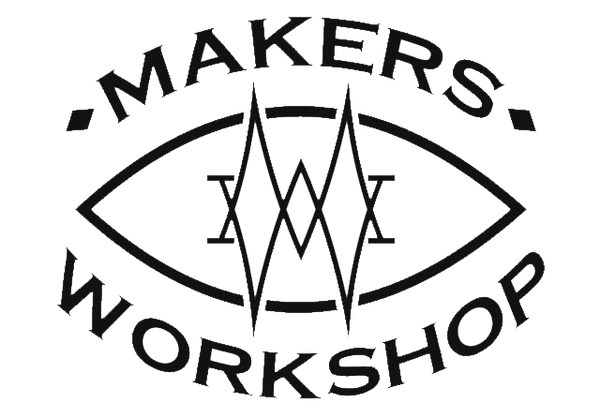First, I ran each piece of wood through the drum sander and cut one flat edge on each piece using the bandsaw. I stacked the wood onto parallel bar clamps with the flat side down and coated it liberally with Titebond III wood glue.
The next day, I removed the bumps and the squeezed-out glue from the hardened panels. I took a thin sliver off of each panel to give me an even reference edge, and then sliced off a panel about an inch and a half thick. After repeating this with the other panel, I placed both of them back onto the parallel bar clamps with a healthy coat of Titebond III to join them together.
Next, I made a design on Easel to carve out the lazy Susan using our X-Carve CNC router. I ran the carve using a ⅛” endmill.
Now it was back to the wood shop to remove the tabs, and then a quick drum sand to flatten the top.
The cherry slab I was using as a border on my design was pretty warped, so I thought it would be easier for me to cut it into long strips first on the table saw before dimensioning it. Once square, I cut all the strips down to a uniform size. Then I played around with the cherry border until I was happy with the balance of the finished look.
Next, I set up another glue-up on the parallel bar clamps to get this all together. Once the glue dried, I sanded the next two edges with a random orbital sander. I removed the excess glue starting with a card scraper and then moved on to my random orbital sander with a 60 grit.
Now I was ready to start working on making a metal base. I wrapped my squares off with painter’s tape to get a uniform cut on multiple pieces. I then ground down the ends to a taper to help hold the weld.
Next, I placed two tacks on each seam to construct my initial square and filled the seams in with full welds.
Then I had Brooke take care of the bug tracks in the wood while I welded. Once everything was cleaned out, Brooke used the random orbital sander to smooth everything out and get rid of any last glue residue before filling in the voids with resin. This is Total Boat 2:1 high performance epoxy with a Medium Hardener.
While she did that, I got to work on adding the legs to the table base. I cut my pieces down to length on the chop saw, tapered the ends, and then tack welded them into place. I flipped the base over to make sure it was level, and then cruised along running full beads along each seam. I cleaned up the completed welding with my angle grinder and an abrasive pad.
After cleaning up, I mixed up some Bondo to take care of the large holes on the sides of the table base. I let it harden for about 20 minutes and then I sanded the Bondo down with a random orbital sander.
Then I squared off the edges of the tabletop with a jigsaw. Meanwhile, I put a coat of black primer onto the base. I then drilled holes into the frame for attaching the two pieces together later on, and widened all of them with a step bit. I gave the base another quick hand sand, and then wiped it down with acetone.
Brooke then hit the tabletop with a final drum sand. She filled the void on the underside of the table with some scrap MDF to ensure an even sanding job, and then took care of some bug tracks she hadn’t noticed before.
Next, we used the card scraper to scrape off the excess resin, and I used the random orbital sander at a 120 grit to remove what was left. I sanded the tabletop up to a 220 grit and then ran the edges through the joiner.
After that, I used my router table to make those edges just a little bit softer before the finish. I cleaned off any excess sawdust with paint thinner. Once that dried, I dumped on the first coat of satin wipe-on poly. I worked this into place with a clean cloth. After the first coat dried, I sanded it lightly with a 220 grit sandpaper and applied the second coat.
To attach the tabletop to the base, I marked where the holes in the metal were onto the wood. I then drilled a pilot hole in each spot and sealed off the seam with caulking. For the outer rim, I mixed up some resin and jumped it into the seam.
Getting the lazy Susan into place was the most challenging part of this whole build. I lined everything up in place carefully and then screwed everything into place piece by piece.
I used a combination of CA glue and wood glue to add a little extra hold to the brace piece before screwing it into place. From there, I was able to easily access the bottom of the lazy Susan to screw it into place as well. I double-checked that it spun well, and then put feet on the bottom of the legs.
Then the build was done and ready for delivery. The table filled the space very nicely and looked great in the room. It was definitely a success!
